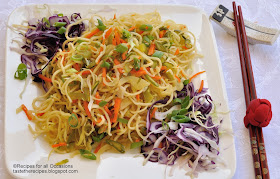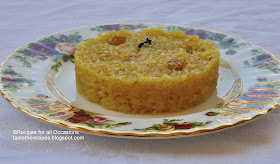This is a beautiful and very flavorful version of the traditional chowmein. In this preparation, I have added lots of vegetables and these lend a hand in making the noodles even more flavorful. When I was a kid, I never liked ginger in my noodles and always protested when I detected ginger when my Mom made chowmein for me. But now I realize that garlic and ginger together give this a deeper flavor.
Recently when I made it for my kids and their friends, they loved it and polished off their plates. That was probably the best compliment I could ever get on how good these tasted.
Ingredients
2 tbsp oil
2 tbsp finely grated ginger
2 tbsp finely minced garlic
1 tsp garlic red chilli paste
1 tbsp soy sauce
2 tsp vinegar
1-2 chillies (optional)
1 onion, finely sliced
15 green beans, finely sliced
1 green bell pepper, finely sliced
2 carrots, grated/finely sliced
¼ cabbage, shredded finely
10 scallions/green onions, finely sliced (separate the white onion part and the leaves)
salt to taste
one packet of chowmein, boiled per directions on the packet
Method
In a large pan or wok, heat up the oil. Once hot, add ginger and garlic and let it cook. Once slightly browned, add in the chillies, if using and then add the garlic red chilli paste. Let it cook for a couple of mins and then add the onions and the white part of the scallions. Fry the onions till cooked, then add the soy sauce and vinegar. Next add the green beans, stir fry and let it cook for a couple of minutes till adding the next vegetable. Add the bell pepper, then carrots and then the cabbage. Add half of the green scallion leaves. Cook the vegetables till they are cooked but still crispy. Don’t overcook these. Season the vegetables with a little salt and then add the noodles. Toss the noodles in till well mixed with the vegetables. Garnish with the remaining scallion greens. Serve hot.
Tips
Add a little oil and salt to the water in which the noodles are boiled to prevent them from sticking. Also, after cooking, drain the water and toss the noodles in a teaspoon of oil. This will prevent them from sticking as they cool down.Taste the noodles and then adjust the salt when you finish off the dish. Since soy sauce is also salty, it is important to taste the noodles before adding more salt.
To make the garlic red chilli paste, soak 4-5 red chillies for a couple of hours. Then add 4-5 cloves of garlic to it and then grind these together. This can be stored in the fridge for a week to 10 days. You can also use sambal oelek paste which is a red chilli paste in vinegar instead of the garlic red chilli paste.
To make the garlic red chilli paste, soak 4-5 red chillies for a couple of hours. Then add 4-5 cloves of garlic to it and then grind these together. This can be stored in the fridge for a week to 10 days. You can also use sambal oelek paste which is a red chilli paste in vinegar instead of the garlic red chilli paste.

























